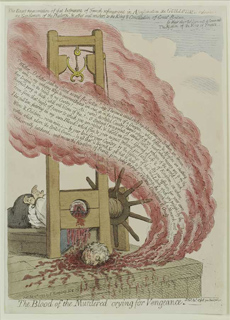Friday was Bastille Day so the theme of this week’s picture is the French Revolution. James Gillray’s gory hand-coloured etching, The Blood of the Murdered Crying out for Vengeance, commemorates the execution of Louis XVI in the Place de la Revolution (now Place de la Concorde) in early 1793.
Working less than a month after the event, the artist presented the regicide both as a news story – a shock-horror sensation – and as a modern martyrdom. The features of the king’s severed head seem composed and almost complacent. Gillray had probably read newspaper reports of the resigned and impressively calm speech which Louis XVI – or plain “Citizen Capet” as he was renamed by his accusers – had made from the scaffold. “People, I die innocent of the crimes imputed to me! I pardon the authors of my death, and pray to God that the blood you are about to shed may not fall again on France!” In Gillray’s picture the blood in question miraculously vapourises as it is shed, turning into a cloud of anguished and accusatory words, floating heavenwards: “Whither, o whither shall my blood ascend for justice?” It is a weird and memorable image, suspended uneasily between the grotesque and the high-flown.
Gillray’s print sold in large quantities, marking not just the death of a king but also a decisive shift in English attitudes to the French Revolution. At first, most Englishmen had celebrated the end of Bourbon despotism and the establishment of a constitutional monarchy. To those of the Whiggish persuasion, it seemed that the French were simply carrying out their own version of England’s Glorious Revolution of 1688. But the September massacres, the execution of the King and the onset of the Terror proved them wrong. By early 1793 not too many...


